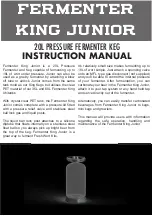
- 45 -
5
INSTRUMENTS, MEASURING IN FLOATING MODE
Battery-operated digital multimeters are suitable for conducting measurements. They can also
test diodes and transistors in many applications. Only high-quality, interference-proof instruments
(e.g. Fluke 75) are suitable for measuring output voltage.
On TIG systems, do not attempt to measure on the load side of the HF reactor (X3) as the voltage
of the HF pulses is so high that it could destroy the instruments. Preferably, measure at the con-
nection for MMA (X7).
When an oscilloscope is used for measuring, it should be powered from an isolating transformer.
Otherwise, connect the measuring earth to the protective conductor.
When the oscilloscope is powered via an isolating transformer and a disconnected protective con-
ductor, the enclosure of the oscilloscope has the potential of the measuring earth selected and
must not be 'touched' by a high voltage (e.g. link voltage).
When two probes are used, make sure that the earth terminals are connected to a common point.
For current measurements, current-measuring prongs are suitable for DC and AC current. An os-
cilloscope should be used to check the correct welding process as well as waveform in case of
AC current. The current can be measured via a suitable shunt or a transformer shunt.
6
OPENING THE SYSTEM
This section describes the enclosure of the DTG405, how to open the unit and how to dismantle
it to a certain degree. Depending on how the fault can be localised, not all of the steps may be
necessary.
Do not start by slackening screws on the base plate since you might accidentally loosen magnetic
components, power rectifier, or heat-sink mounts.
1.
Pull the mains plug.
2.
Unscrew the U-shaped cover.
3.
Unscrew the side panel at the bottom on each side.
4.
The side panels of the power block can be removed from the side without having to disman-
tle the entire power block.
5.
Discharge the electrolytic capacitors (with resistance).
6.
You can remove the connections, i.e. the busbars, between the heat sink modules by slack-
ening the screws.
7.
You can unplug or unscrew all the cables leading to the heat sink modules. Before unplug-
ging, make sure you mark their position. This will avoid incorrect wiring later when you re-
assemble the module.
8.
The heat sink modules are secured in their holders by screws on the sides. You can remove
each heat sink module separately.
Содержание Aristotig 405 AC/DC
Страница 1: ...0458 165 002 9910 DTG 405 Aristotig 405 AC DC Welding rectifier Service manual...
Страница 9: ...9 NOTES...
Страница 10: ...10 CONNECTION DIAGRAM DTG 405...
Страница 11: ...11...
Страница 15: ...15 NOTES...
Страница 16: ...16 BLOCK DIAGRAM DTG 405 405a pcx...
Страница 17: ...17 Warning Some parts of this circuit are connected to mains voltage potential 405b pcx...
Страница 27: ...27 A2 COMPONENT POSITIONS a2 1b pcx a2 2b pcx...
Страница 30: ...30 A4 A11 COMPONENT POSITIONS Warning The circuit and its parts are connected to mains voltage potential...
Страница 40: ...40 A9 A13 COMPONENT POSITIONS A10 A14 COMPONENT POSITIONS...
Страница 57: ...57 209 201 212 203 204 205 206 207 208 D04 0301 1 214 215 216 218 217 219 220 110 221 222 213 202...
Страница 62: ...62 8 WAVEFORM AC2 SMOOTH WAVE ac2 pcx...
Страница 67: ...67 LOAD CHARACTERISTICS NOTES 0 10 20 30 40 50 60 70 80 90 0 50 100 150 200 250 300 350 400 A V TIG MMA DTG 405...
Страница 81: ...81 NOTES...
Страница 86: ...86 D04 0304 1 D04 0305 0 501 502 503 502 502 504 505 506 507 508 509 510 511 512 513 515 516 505 517...
Страница 91: ...page...
















































